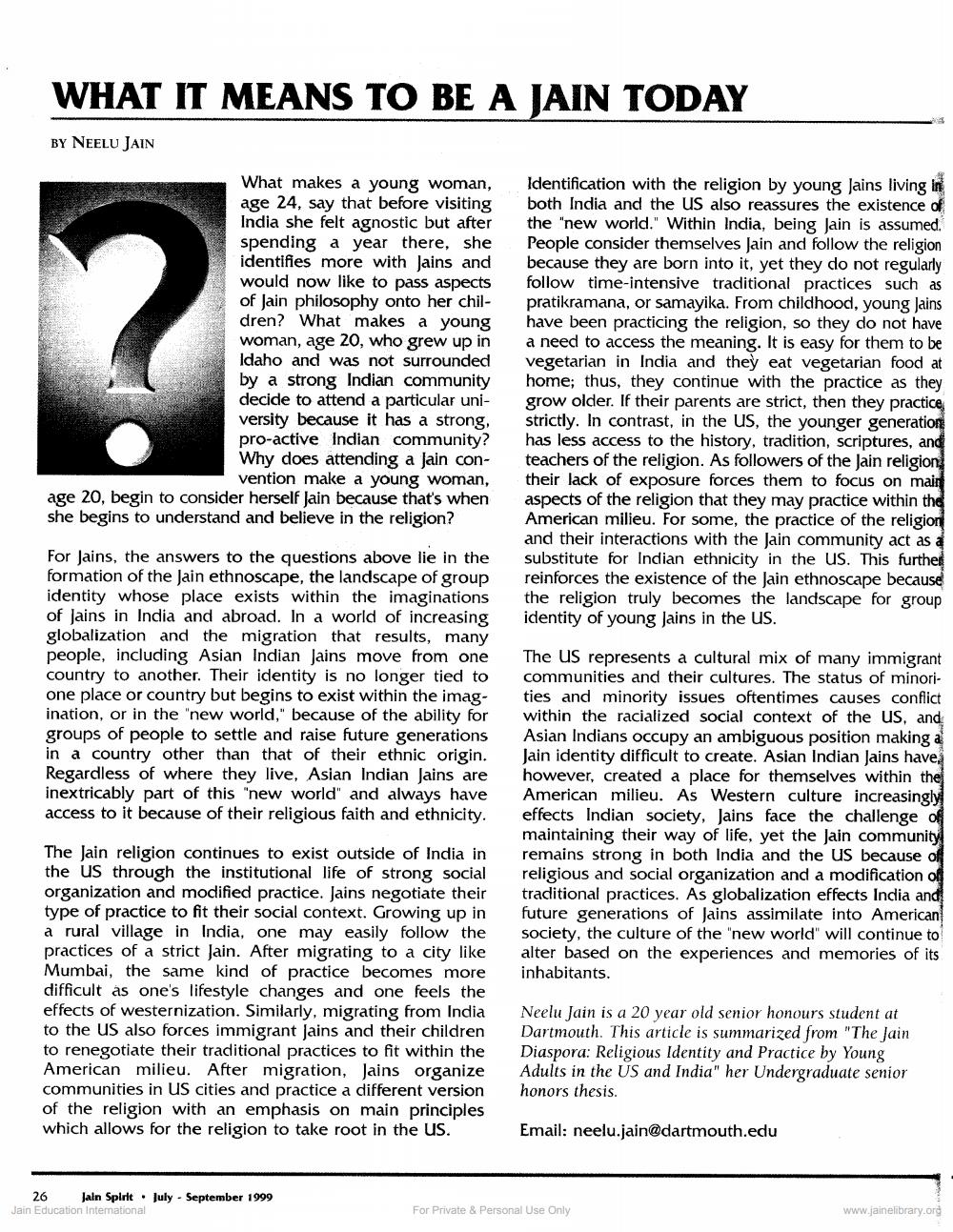________________
WHAT IT MEANS TO BE A JAIN TODAY
BY NEELU JAIN
?
What makes a young woman, age 24, say that before visiting India she felt agnostic but after spending a year there, she identifies more with Jains and would now like to pass aspects of Jain philosophy onto her children? What makes a young woman, age 20, who grew up in Idaho and was not surrounded by a strong Indian community decide to attend a particular university because it has a strong, pro-active Indian community? Why does attending a Jain convention make a young woman, age 20, begin to consider herself Jain because that's when she begins to understand and believe in the religion?
For Jains, the answers to the questions above lie in the formation of the Jain ethnoscape, the landscape of group identity whose place exists within the imaginations of Jains in India and abroad. In a world of increasing globalization and the migration that results, many people, including Asian Indian Jains move from one country to another. Their identity is no longer tied to one place or country but begins to exist within the imagination, or in the "new world," because of the ability for groups of people to settle and raise future generations in a country other than that of their ethnic origin. Regardless of where they live, Asian Indian Jains are inextricably part of this "new world" and always have access to it because of their religious faith and ethnicity.
The Jain religion continues to exist outside of India in the US through the institutional life of strong social organization and modified practice. Jains negotiate their type of practice to fit their social context. Growing up in a rural village in India, one may easily follow the practices of a strict Jain. After migrating to a city like Mumbai, the same kind of practice becomes more difficult as one's lifestyle changes and one feels the effects of westernization. Similarly, migrating from India to the US also forces immigrant Jains and their children to renegotiate their traditional practices to fit within the American milieu. After migration, Jains organize communities in US cities and practice a different version of the religion with an emphasis on main principles which allows for the religion to take root in the US.
26 Jain Spirit July-September 1999 Jain Education International
Identification with the religion by young Jains living in both India and the US also reassures the existence of the "new world." Within India, being Jain is assumed. People consider themselves Jain and follow the religion because they are born into it, yet they do not regularly follow time-intensive traditional practices such as pratikramana, or samayika. From childhood, young Jains have been practicing the religion, so they do not have a need to access the meaning. It is easy for them to be vegetarian in India and they eat vegetarian food at home; thus, they continue with the practice as they grow older. If their parents are strict, then they practice strictly. In contrast, in the US, the younger generation has less access to the history, tradition, scriptures, and teachers of the religion. As followers of the Jain religion their lack of exposure forces them to focus on main aspects of the religion that they may practice within the American milieu. For some, the practice of the religion and their interactions with the Jain community act as a substitute for Indian ethnicity in the US. This further reinforces the existence of the Jain ethnoscape because the religion truly becomes the landscape for group identity of young Jains in the US.
The US represents a cultural mix of many immigrant communities and their cultures. The status of minorities and minority issues oftentimes causes conflict within the racialized social context of the US, and Asian Indians occupy an ambiguous position making a Jain identity difficult to create. Asian Indian Jains have however, created a place for themselves within the American milieu. As Western culture increasingly effects Indian society, Jains face the challenge of maintaining their way of life, yet the Jain community remains strong in both India and the US because of religious and social organization and a modification of traditional practices. As globalization effects India and future generations of Jains assimilate into American society, the culture of the "new world" will continue to alter based on the experiences and memories of its inhabitants.
Neelu Jain is a 20 year old senior honours student at Dartmouth. This article is summarized from "The Jain Diaspora: Religious Identity and Practice by Young Adults in the US and India" her Undergraduate senior honors thesis.
Email:
[email protected]
For Private & Personal Use Only
www.jainelibrary.org




